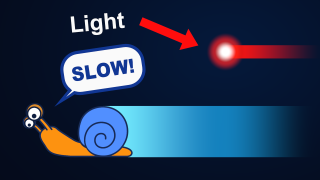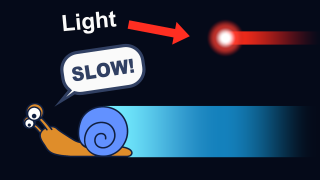The Speed of Light is EXTREMELY Slow
Published: June 20, 2022 at 8:48 PM (PT)
7:54
(14238 frames/30fps) Resolution:1920x1080
(FHD) Most Rewatched:2:02 to 2:14 Realtime Statistics...
30 Minutes...
Hour...
24 Hours...
Corrections
...less than one seventh of a second!
One eighth of a second is 0.125 seconds which is less than the time it takes for light to travel around the Earth (0.1334518 seconds). So this should be "less than one seventh of a second", one seventh of a second being about 0.1429 seconds.Information Sources
https://en.wikipedia.org/wiki/Light
Light is the Fastesthttps://imagine.gsfc.nasa.gov/features/cosmic/nearest_star_info.html
NASA Planetary Factsheethttps://nssdc.gsfc.nasa.gov/planetary/factsheet/planet_table_british.html
Light was the First Thing Createdhttps://www.bbc.co.uk/bitesize/guides/zg3vxfr/revision/1
Electromagnetic Spectrumhttps://astronomy.swin.edu.au/cosmos/E/Electromagnetic+Spectrum
Electromagnetic Spectrum (2)https://en.wikipedia.org/wiki/Light#/media/File:EM_spectrum.svg
Light is a Physical Objecthttps://www.deviantart.com/cestarian/journal/Understanding-Light-617613461
Radio Telescopeshttps://public.nrao.edu/telescopes/radio-telescopes
Colors of the Rainbowhttps://www.britannica.com/video/185543/colours-rainbow
Primary Colors of Light and Inkhttps://learn.leighcotnoir.com/artspeak/elements-color/primary-colors
Magenta Doesn't Existhttps://scholarblogs.emory.edu/artsbrain/2020/12/02/magenta-doesnt-exist
Speed of Soundhttps://en.wikipedia.org/wiki/Speed_of_sound
Closest Stars Distanceshttps://www.visualcapitalist.com/the-44-closest-stars-and-how-they-compare-to-our-sun
Rigel Factshttps://en.wikipedia.org/wiki/Rigel
Milky Way Factshttps://imagine.gsfc.nasa.gov/features/cosmic/milkyway_info.html
Observable Universe Factshttps://en.wikipedia.org/wiki/Observable_universe
Graphic Sources
https://www.jpl.nasa.gov/images/pia10748-our-milky-way-gets-a-makeover-artist-concept
Light Bulb (kinggodarts)https://pixabay.com/vectors/bulb-light-electricity-energy-lamp-6602798
Yellow Car (Daniel Roberts)https://www.alamy.com/just-an-orange-car-image471694088.html
Snail (Daniel Roberts)N/A
EMR-c (Daniel Roberts)N/A
Audio Sources
N/A
To the Galaxy (Daniel Roberts)https://pixabay.com/music/ambient-to-the-galaxy-10734
Spinning1 (Daniel Roberts)N/A
Mulitmedia button switch 07 (Unknown)N/A
Mulitmedia button switch 06 (Unknown)N/A
Car stopping2 (Daniel Roberts)N/A
Electric Iris (Daniel Roberts)N/A
Pop2 (Daniel Roberts)N/A
Crash (Eponn)https://freesound.org/people/Eponn/sounds/420356
Spring boing 06 (Unknown)N/A
Car drive away1 (Daniel Roberts)N/A
Spring boing 01 (Unknown)N/A
Light fast1 (Daniel Roberts)N/A
Snail2 (Daniel Roberts)N/A
Snail 3 (Daniel Roberts)N/A
Snail1 (Daniel Roberts)N/A
Transcended-Inspiring Cinematic (Daniel Roberts)https://pixabay.com/music/main-title-transcended-inspiring-cinematic-13432
Deep Space-Slow Ambient Loop (Daniel Roberts)https://pixabay.com/music/ambient-deep-space-slow-ambient-loop-93637
Wind, Synthesized, A (InspectorJ)https://freesound.org/people/InspectorJ/sounds/376415
Counting1 (Daniel Roberts)N/A
Snail4 (Daniel Roberts)N/A
Snail5 (Daniel Roberts)N/A
Spinning2 (Daniel Roberts)N/A
Chapters
Introduction
0:35What is light made of?
2:29Light vs Sound
3:12Comparing the speed of light
7:22The speed of light is slower than a snail
The speed of light is exactly
670,616,629 miles per hour
or 299,792,458 meters per second
and is believed to be the
fastest speed in the Universe.
To put that into perspective,
light can travel around the entire
Earth over 7 times in just one second!
But that's actually quite slow.
It only appears fast to us since we're
just a microscopic dot in
an infinitely large Universe.
Let's look at the speed of light from
a much larger perspective, although first
we need to understand a few
things about light.
Light was the first thing
created in the Universe but
what is light made of?
Light is electromagnetic radiation.
However, most people will connect the
term light with visible light which is
what your eyes are sensitive to,
but visible light is only a very small
portion of the electromagnetic spectrum.
Besides visible light, the electromagnetic
spectrum also includes Gamma Rays,
X-Rays,
Ultraviolet,
Infrared,
Microwaves,
and Radio Waves.
The wavelength of light is what
determines it's category,
or in the case of visible light,
it's color.
But what is electromagnetic radiation?
Electromagnetic radiation, or light, is
propagated by small particles known as Photons.
Since light is actually a physical object,
or more accurately,
billions of tiny physical objects,
light does actually apply force to
any object it hits.
However, since light is so, well...light,
this doesn't have much of an effect on a
large scale. So, no,
you can't put a laser pointer under
your car in place of a jack.
Unlike other sections of the
electromagnetic spectrum which are
most often observed in black and white,
visible light is observed in a whole
variety of colors. The best demonstration
of this is the rainbow.
Although most people think there's 7 colors
in the rainbow, there's actually much more.
What we observe as colors are actually
just different wavelengths of visible light.
So red, is the longest visible wavelength
and violet is the shortest visible wavelength.
And, of course, there's more then just
7 wavelengths in between those two.
The primary colors of light are often
confused with the primary colors of ink.
While the primary colors of ink are
cyan, magenta, and yellow,
the primary colors of light are
red, green, and blue.
In fact, magenta doesn't actually exist
anywhere on the electromagnetic spectrum,
magenta is actually a combination of
the shortest and longest ends
of the spectrum.
While I could go on forever about
what exactly light is and how it works,
we should probably move on.
How does the speed of light compare
to the speed of sound?
The best representation of just
how much faster the speed of light is
compared to the speed of sound
is seen every time there's a thunderstorm.
When you see a flash of lightning that's say
10 miles in the distance, you see it just
54 microseconds or 0.00005 seconds
after it actually happened.
Yet the thunder, or sound, takes
over 47 seconds.
That's nearly 1 million times
slower than light!
So if light is so much faster than sound,
then how is the speed of light so slow?
Well, because we've just been looking at
what happens on our own tiny planet,
there's still a whole Universe out there!
And when the speed of light is compared
to the whole Universe,
it becomes a snails pace.
Let's board a newly invented spacecraft
that is capable of traveling at
the speed of light.
We'll call it the EMR-c,
short for ElectroMagnetic Radiation and c
which is commonly used to represent
the speed of light.
We'll start on Earth and begin exploring
the rest of the Universe.
We should probably do a quick flight
around the Earth first, just to make sure
all our systems are working correctly.
Uh...
That was pretty quick.
About 0.134 seconds to make that flight.
Anyway, it looks like the systems are
working fine so let's head to the Sun next.
It's our closest neighbouring star,
so this shouldn't take very long.
Ok, this is taking a while,
let's fast forward a bit.
And...
We've arrived.
According to our clock, that took
a little under 8 minutes and 20 seconds.
Let's zero out our stopwatch here,
and compare everything to their
distance from the Sun.
Alright, let's head to the orbit of Neptune.
We just went from the Earth to
the Sun in a few minutes, so
this shouldn't take too long.
Let's fast forward a bit.
Ok, I guess I was wrong again.
It's already been an hour and we still
haven't reached Neptune.
I guess we'll have to fast forward even more.
Well, that was the most boring ride of my life!
Over 4 hours and we've finally reached
the orbit of Neptune!
Alright, let's head to Proxima Centauri,
our second closest neighbouring star.
It's quite a ways away, so it will take
at least a few months to get there.
Welp, it's been a year and we're still
not there.
I guess we'll have to fast forward
even more!
And, we've arrived.
That took about 4 years and 3 months!
I'm beginning to think this tour is gonna
take a bit longer than expected.
Let's take a trip to Sirius,
the brightest star in the sky.
Other then the Sun, that is.
Well, here we are.
Looks like that took us about
8 years and 8 months.
Crazy that we were still traveling at
the same speed that allowed us to
fly around the Earth in less than
one eighth of a second!
Anyway, let's continue our journey.
Looks like our next stop is Rigel.
I think it's quite a ways away so
let's switch to our engines that can
propel us at 100 times the
speed of light!
I know we're going at 100 times
the speed of light, but
this seems like it's taking a very long time.
I think we're going to have to
fast forward quite a bit.
Ok, that's Rigel.
It took us 8 years and nearly 8 months
to get here at 100 times the speed of light!
The worst part is, we're not even
close to the edge of our own galaxy!
So, let's travel to the edge of our galaxy.
Let's switch engines again.
This time, we'll travel at 10 thousand times
the speed of light!
And here we are!
The edge of the Milky Way galaxy!
It took us 2 and a half years to travel here.
And believe it or not, that was only
about one quarter of the distance
across the entire Milky Way!
Alright, it's time we see just how slow
the speed of light really is.
This time, we're going to switch our
engines to 1 billion times the speed of light,
which is over 186 trillion miles per hour!
Let's use this new speed to travel in
a circle around the entire observable Universe.
I hope you're ready for a very,
very, long journey.
It's now been a century!
But we're not even half done, so...
you might want to take up knitting or something.
Alright! We've now finished our trip around
the entire observable Universe.
It's been nearly 300 years.
Let's switch our clock back to light-years so
we can better compare to traveling
around the Earth.
Wait?! What's that number?
Oh, yeah,
we were traveling at 1 billion times
the speed of light.
Remember how the speed of light when
compared to the Universe becomes a
snails pace?
Well, a snail could travel around the
entire orbit of Neptune over 3000 times
before light could travel around
the observable Universe, once!
So, either the speed of light is
extremely slow
or the Universe is
extremely large.
In fact
it could even be both.


 June 20, 2022
June 20, 2022